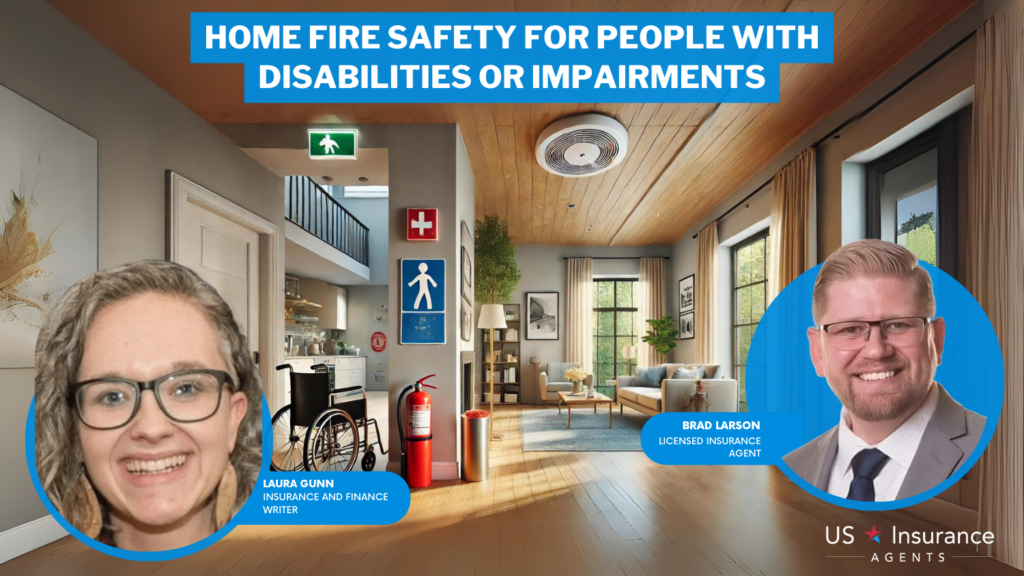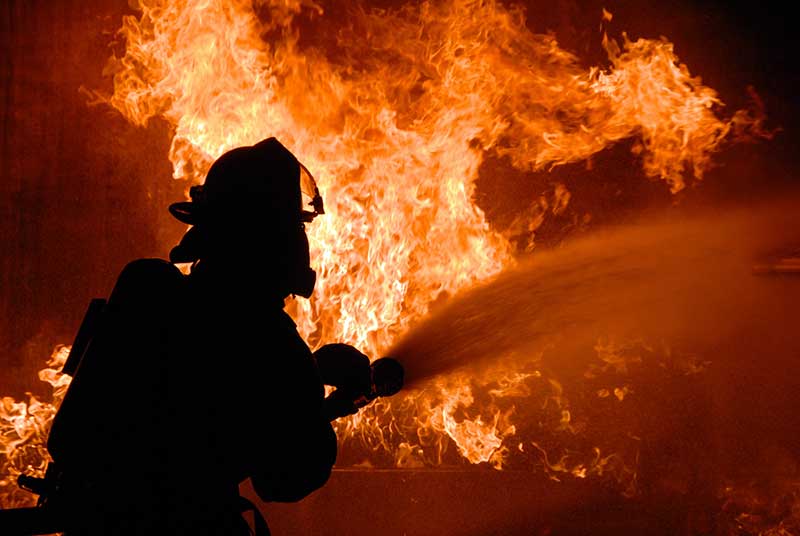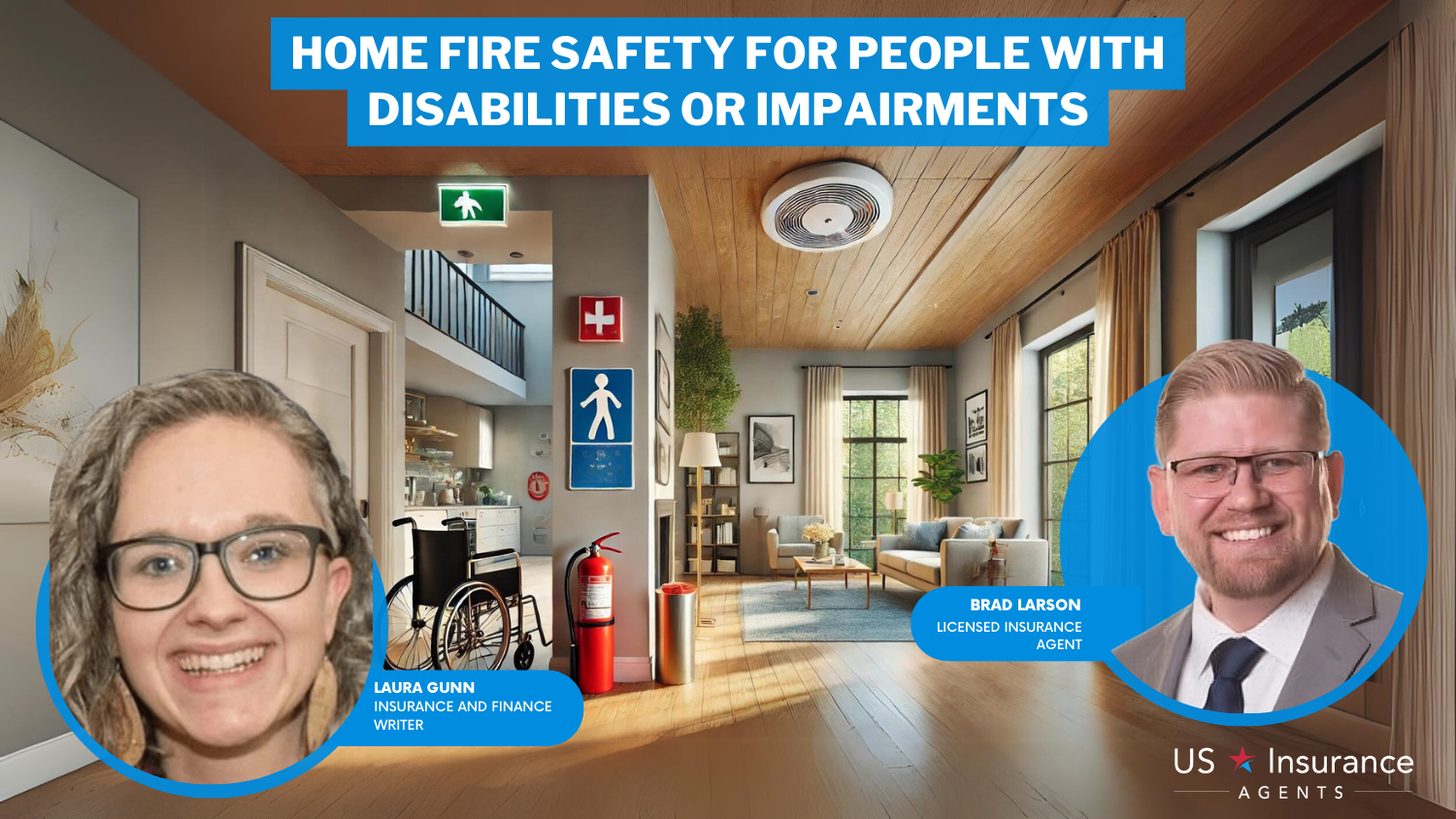Home Fire Safety for People with Disabilities or Impairments
Empower Individuals with Disabilities: Discover Essential Home Fire Safety Tips, Resources, and Support for a Secure Living Environment. Gain invaluable insights to ensure the safety and well-being of individuals with disabilities in the event of a fire. Our comprehensive guide provides practical advice on creating fire-safe homes, including customized evacuation plans, accessible fire alarms, and assistive technologies.
Read moreFree Home Insurance Comparison
Compare Quotes From Top Companies and Save
Secured with SHA-256 Encryption
Brad Larson
Licensed Insurance Agent
Brad Larson has been in the insurance industry for over 16 years. He specializes in helping clients navigate the claims process, with a particular emphasis on coverage analysis. He received his bachelor’s degree from the University of Utah in Political Science. He also holds an Associate in Claims (AIC) and Associate in General Insurance (AINS) designations, as well as a Utah Property and Casual...
Licensed Insurance Agent
UPDATED: Jan 15, 2025
It’s all about you. We want to help you make the right coverage choices.
Advertiser Disclosure: We strive to help you make confident insurance decisions. Comparison shopping should be easy. We are not affiliated with any one insurance company and cannot guarantee quotes from any single insurance company.
Our insurance industry partnerships don’t influence our content. Our opinions are our own. To compare quotes from many different insurance companies please enter your ZIP code above to use the free quote tool. The more quotes you compare, the more chances to save.
Editorial Guidelines: We are a free online resource for anyone interested in learning more about insurance. Our goal is to be an objective, third-party resource for everything insurance related. We update our site regularly, and all content is reviewed by insurance experts.
UPDATED: Jan 15, 2025
It’s all about you. We want to help you make the right coverage choices.
Advertiser Disclosure: We strive to help you make confident insurance decisions. Comparison shopping should be easy. We are not affiliated with any one insurance company and cannot guarantee quotes from any single insurance company.
Our insurance industry partnerships don’t influence our content. Our opinions are our own. To compare quotes from many different insurance companies please enter your ZIP code above to use the free quote tool. The more quotes you compare, the more chances to save.
On This Page
Welcome to our comprehensive guide on Home Fire Safety for People with Disabilities or Impairments. In this article, we address the unique challenges faced by individuals with disabilities or impairments when it comes to fire safety.

We provide essential tips and strategies to ensure a safe living environment, including customized evacuation plans, assistive technologies, and accessible fire alarms. Learn about the importance of fire prevention, early detection, and effective emergency response.
To safeguard your home and loved ones, it’s crucial to have the right insurance coverage. Enter your zip code below to compare rates from the best insurance providers and ensure your home is protected. Don’t compromise on safety and be proactive in creating a fire-safe environment for everyone in your household.

Visual Impairments
We often use sight to determine how dangerous fire is and how best to avoid it or extinguish it. People with a visual impairment are at a higher risk of injury or death if there is a fire because they need to rely on their other senses instead. They are also more likely to start accidental fires and experience more difficulty in putting out small fires without injury.
There are some precautions that can be taken to lower these risks:
- Consider living on the ground floor when possible. It will make evacuation easier.
- Wherever you are living, practice your escape plan.
- Invest in a fire alarm that buzzes at a lower decibel so people can still be heard over it.
- Avoid overloading outlets.
- Avoid open flames when possible.
- Do not walk away from a stove that is on or still hot.
- Keep space heaters and chimneys clear of dust and debris.
Resources:
- Washington State Association of Fire Marshalls: Fire safety solutions for people with disabilities
- Collierville Fire Department: Home safety for people with disabilities
- Maine Government: Fire safety tips for people with disabilities
Compare The Best Insurance Quotes In The Country
Compare quotes from the top insurance companies and save!
Secured with SHA-256 Encryption
Hearing Impairments
Individuals with hearing impairments are less likely to notice a traditional fire alarm going off, especially if they have removed a hearing aid before going to bed. Because of this, one of the best things you can do for fire safety is to invest in a fire alarm created specifically for deaf and hard of hearing people. Fire alarms for the hearing impaired include strobe lights as well as bed-shakers.
In addition to the proper fire alarm, practice fire prevention:
- Make sure that batteries in smoke alarms are replaced frequently.
- Store flammable liquids safely.
- Inspect electrical appliances and wiring.
Resources:
- Marshalltown Iowa: Fire safety for the disabled
- University of Maryland: Fire safety for older adults and people with disabilities
- Penn State: Fire risks for the deaf or hard of hearing
Physical Disabilities
People with physical disabilities have a higher risk when it comes to causing fires. They are also more at risk of being injured or dying in a home fire. Physical disabilities may make escaping a burning building more difficult and, because of that, may slow down evacuation.
It is vitally important to practice fire safety. Consider implementing the following:
- Have an escape plan.
- Build an emergency exit ramp.
- Keep your bedroom and the living area near an exit.
- Make sure that your mobility devices can all fit through the doors and hallways in the building.
- Have locks that are easy to open on your doors and windows.
Resources:
- Sandy Spring Volunteer Fire Department: Fire safety for people with disabilities
- National Park Service: Fire prevention 52: Fire safety for people with disabilities
- City of St. Charles: People with disabilities fire safety checklist
Cognitive Impairments
People with cognitive disabilities also have a significantly higher risk when it comes to dying in a home fire. This is why it is important to consider their unique needs when designing an escape plan and practice home fire drills following that plan regularly so they can be familiar with the procedures.
When creating a plan, ask yourself the following questions:
- Are your escape routes clearly marked?
- Are there handrails along the escape route and on stairs?
- Have you discussed how to recognize an emergency and what the signs are?
- Will someone with autism be less likely to accept a route they have not practiced previously?
- Are there any physical disabilities that also need to be considered when making the plan?
- Is your escape route wide enough for more than one person if an assistant is needed?
Resources:
- US Fire Administration: Fire safety outreach materials for people with disabilities
- New York University: 5 steps to promote safety for children with autism spectrum disorder
Compare The Best Insurance Quotes In The Country
Compare quotes from the top insurance companies and save!
Secured with SHA-256 Encryption
Children
Children also need extra attention when it comes to fire prevention and evacuation plans. Practice and education are essential when it comes to going through your escape route and plans.
Here are some additional things you can do to keep your family safe:
- Mark evacuation routes with pictures or signs.
- Give them contact information for someone to reach out to once they are safely away from danger.
- Teach them fire safety and respect of fire to help prevent accidental fires at home.
- Keep flammable items out of reach.
- Keep clutter to a minimum.
Resources:
- Home Fire Drill: Help Mikey make it out
- Prevention1st: Protect your family from fire
- Suffolk County Government: Teaching children fire safety
Pets
Include pets in your escape route practice, so they know to follow (if they can). In addition to making them a part of your evacuation plan, you will also want to consider pets when it comes to fire prevention. Pets can knock over, knock into, or jump on potentially flammable and dangerous materials.
If you have a pet or plan to get one, make sure to pet-proof your home with fire prevention in mind:
- Cover or remove stove knobs.
- Leave signs visible for firefighters, so they know there are pets in the house.
- Keep cords and wires out of reach, so they do not get chewed on.
- Do not leave pets alone near candles or other open flames.
- Keep flammable materials secured so they cannot be knocked over or into.
Resources:
- College of Veterinary Medicine, University of Missouri: Plan for family and pets in case of disaster
- The University of Illinois at Urbana-Champaign, College of Veterinary Medicine: Smoke alarm: Dangers of smoke inhalation for pets
Additional Resources
Are you looking for more ways to prevent fires in the home and stay safe if one occurs? The Centers for Disease Control and Prevention have links to several sources of information on their fire prevention page. Ready.gov also has a section on what you can do during home fires.
Compare The Best Insurance Quotes In The Country
Compare quotes from the top insurance companies and save!
Secured with SHA-256 Encryption
Case Studies: Home Fire Safety for People with Disabilities or Impairments
Case Study 1: Enhancing Accessibility and Alarm Systems
In this case study, we examine the experience of John, a wheelchair user with limited mobility. John lives alone and relies on a power wheelchair for mobility. To address his specific needs, he collaborated with a fire safety professional to enhance the accessibility of his home and install specialized alarm systems.
This case study explores the modifications made, including accessible exit routes, the integration of smoke alarms with visual and tactile alerts, and the utilization of smart home technology to assist John during an emergency.
Case Study 2: Communication Strategies for Deaf or Hard of Hearing Individuals
Sarah, who is deaf, faced unique challenges when it came to fire safety. This case study delves into the solutions implemented to ensure effective communication and prompt response during emergencies. We discuss the importance of visual alarms, the incorporation of vibrating devices or bed shakers, and the use of alerting systems connected to Sarah’s personal communication devices.
Additionally, the case study explores the role of fire safety education and the development of communication plans tailored to Sarah’s specific needs.
Case Study 3: Safe Evacuation for Individuals with Mobility Impairments
In this case study, we examine the story of David, who experiences mobility impairments due to a spinal cord injury. David’s situation highlights the significance of personalized evacuation plans and assistive devices. We explore the installation of stair glides or lifts, the positioning of emergency evacuation chairs, and the coordination with local emergency services to ensure a swift and safe evacuation process.
This case study emphasizes the importance of practicing evacuation drills and involving caregivers or neighbors in emergency preparedness.
Case Study 4: Cognitive Impairments and Fire Safety Precautions
The case study of Maria examines the challenges faced by individuals with cognitive impairments, like dementia or intellectual disabilities, in maintaining home fire safety. It emphasizes the use of simple strategies, such as removing fire hazards and providing visual cues for evacuation, to address these challenges. The study also explores the importance of caregiver training and community support networks in ensuring Maria’s safety.
Case Study 5: Fire Safety for Individuals with Respiratory Conditions
This case study focuses on Emily, who relies on oxygen therapy for her respiratory condition. It examines the specific fire safety considerations for individuals using medical equipment like oxygen tanks. The study highlights the importance of fire-resistant materials, regular equipment maintenance, and tailored emergency plans for individuals like Emily. It also emphasizes the need for backup power sources and collaboration with healthcare providers to ensure comprehensive fire safety measures.

Frequently Asked Questions
What are some extra precautions that people with disabilities or impairments should take to prevent home fires?
People with disabilities or impairments may have unique challenges when it comes to fire safety, so it’s important to take extra precautions. For example, they may need to install additional smoke detectors or fire alarms, use flameless candles instead of traditional candles, and avoid using space heaters or other heating equipment that could be a fire hazard.
How can people with mobility impairments escape from a fire in their home?
People with mobility impairments should have a plan in place for how to escape from a fire in their home. This may involve installing special ramps or handrails, having a caregiver or family member assist them in getting out of the house, or having a special evacuation chair or other device to help them get down stairs or out of the house.
What should people with visual impairments do to prepare for a fire in their home?
People with visual impairments should make sure that they have a working smoke detector or fire alarm with an audible alarm. They should also have a plan in place for how to get out of the house in case of a fire, such as using a tactile map or a guide dog to navigate to the nearest exit.
How can people with hearing impairments be alerted to a fire in their home?
People with hearing impairments should install special smoke detectors or fire alarms that have a visual or vibrating alarm in addition to an audible alarm. They should also make sure that they have a plan in place for how to escape from the house in case of a fire, such as using a flashing light or vibrating pager to alert them to the danger.
What should people with cognitive impairments do to prepare for a fire in their home?
People with cognitive impairments may need extra help in preparing for a fire in their home. They may benefit from having a caregiver or family member help them develop a fire safety plan, using simple and clear language to explain fire safety rules, and practicing fire drills regularly.
What should people with respiratory impairments do to protect themselves from smoke in case of a fire?
People with respiratory impairments should have a plan in place for how to protect themselves from smoke in case of a fire. This may involve using a special mask or respirator, staying low to the ground to avoid smoke, or having a caregiver or family member assist them in getting out of the house. They should also have a backup plan in case their primary escape route is blocked by smoke or flames.
Compare The Best Insurance Quotes In The Country
Compare quotes from the top insurance companies and save!
Secured with SHA-256 Encryption
Brad Larson
Licensed Insurance Agent
Brad Larson has been in the insurance industry for over 16 years. He specializes in helping clients navigate the claims process, with a particular emphasis on coverage analysis. He received his bachelor’s degree from the University of Utah in Political Science. He also holds an Associate in Claims (AIC) and Associate in General Insurance (AINS) designations, as well as a Utah Property and Casual...
Licensed Insurance Agent
Editorial Guidelines: We are a free online resource for anyone interested in learning more about insurance. Our goal is to be an objective, third-party resource for everything insurance related. We update our site regularly, and all content is reviewed by insurance experts.


